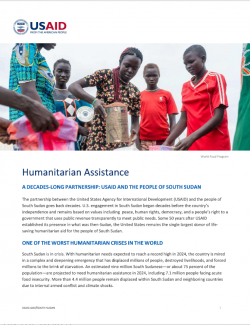A DECADES-LONG PARTNERSHIP: USAID AND THE PEOPLE OF SOUTH SUDAN
The partnership between the United States Agency for International Development (USAID) and the people of South Sudan goes back decades. U.S. engagement in South Sudan began decades before the country's independence and remains based on values including peace, human rights, democracy, and a people's right to a government that uses public revenue transparently to meet public needs. Some 50 years after USAID established its presence in what was then-Sudan, the United States remains the single largest donor of lifesaving humanitarian aid for the people of South Sudan.
ONE OF THE WORST HUMANITARIAN CRISES IN THE WORLD
South Sudan is in crisis. With humanitarian needs expected to reach a record high in 2024, the country is mired in a complex and deepening emergency that has displaced millions of people, destroyed livelihoods, and forced millions to the brink of starvation. An estimated nine million South Sudanese-or about 75 percent of the population-are projected to need humanitarian assistance in 2024, including 7.1 million people facing acute food insecurity. More than 4.4 million people remain displaced within South Sudan and neighboring countries due to internal armed conflict and climate shocks.
Those forced from their homes continue to need immediate assistance such as food, health, nutrition, protection, shelter, and water, sanitation, and hygiene {WASH) services. The April 2023 outbreak of conflict in neighboring Sudan compounded an already-dire humanitarian situation in South Sudan where humanitarian food and essential service operations are stretched to the brink as the country continues a downward spiral of conflict, flooding, and displacement, compounded by lack of infrastructure and governance.
USAID prioritizes needs-based life-saving humanitarian assistance-with appropriate safeguards-which includes food, health, nutrition, protection, shelter, and water and sanitation services in areas with the greatest concentration of people in need. Delivering humanitarian assistance to crisis-affected populations is particularly challenging in South Sudan due to insecurity and the absence of basic infrastructure. Threats and attacks jeopardize the safety of aid workers and impede relief organizations from reaching people in need. Criminal activities, such as ambushing and looting humanitarian trucks and assets, often force temporary pauses in humanitarian operations. USAID prioritizes the safety and security of humanitarian staff and strictly adheres to a zero-tolerance approach for fraud, diversion, and exploitation of staff and resources.
The U.S. government's decades of humanitarian assistance to the people of what is today South Sudan has been and continues to be based on need. During the 1980s, U.S humanitarian assistance increased markedly in response to famine and displacement caused by civil war, affecting the communities that would later become part of South Sudan. USAID spearheaded the emergency response by helping to create Operation Lifeline Sudan, a system that allowed humanitarian assistance to reach vast, previously impenetrable regions of the waraffected south. Today, the United States remains the single largest donor of humanitarian aid for the people of South Sudan, providing over $600 million in fiscal year 2023 and more than $1.8 billion in food assistance over the last five years. As of January 2024, USAID has provided $44 million in direct response to the Sudan crisis, providing new arrivals with life-saving services.
A DETERIORATING HUMANITARIAN EMERGENCY: FOOD INSECURITY, SUBNATIONAL VIOLENCE, AND DISPLACEMENT
Since South Sudan's independence in 2011, humanitarian needs have rapidly increased. In 2012, about 15 percent of South Sudanese depended on emergency assistance to survive; that number is projected to swell to 73 percent in 2024. Over the same period, the number of people facing crisis levels of food insecurity spiraled from nine percent to 56 percent this year-a staggering 522 percent increase. Sub-national violence continues to result in civilian deaths and injuries, hinder humanitarian access countrywide, and drive population displacement. Of the 2.3 million internally-displaced persons in South Sudan, 44 percent cited conflict and 22 percent cited communal clashes as the main drivers of displacement, UNHCR reported in July 2023. Armed violence and worsening security conditions exacerbate food insecurity and malnutrition rates, particularly among children younger than five and pregnant and lactating women. As humanitarian needs rise in South Sudan, the United States is deeply concerned that the Revitalized Transitional Government of National Unity has failed to make an appropriate level of public revenue available to support humanitarian response. Moreover, the transitional government has failed to take much-needed steps to reduce the costs and risks faced by donors, implementing partners, and aid workers.
In response to rising malnutrition, USAID funds critical nutrition services, such as high-energy biscuits and readyto- use therapeutic foods, to address immediate, emergency needs. This assistance reached more than a quarter million children between January and November 2023. In Fiscal Year 2023, USAID reached nearly four million people across the country with in-kind food and livelihoods assistance. Additionally in 2023, USAID assistance reached more than 67 percent of people experiencing crisis or worse levels of hunger, reducing the number of people in need by 400,000; and with USAID funds, the World Food Program facilitated the advance purchase and positioning of food before the 2023 wet season, saving $50 million in transportation costs-enough to provide assistance to an additional 185,000 South Sudanese.

